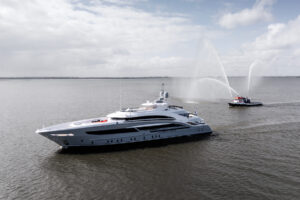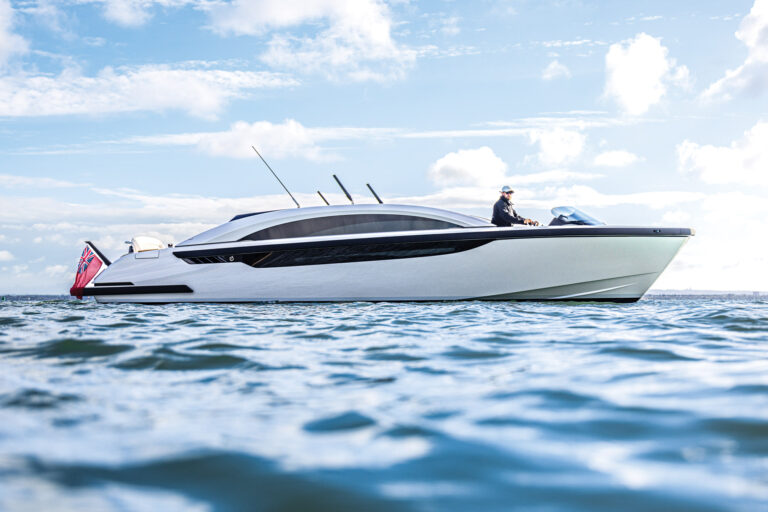Every business experiences defining moments or turning points that change the course of its future. For Carver Yachts, the introduction of the 59 Marquis is likely to be such a moment. More than just the largest Carver ever built, the 59 Marquis marks a significant change in design for the successful builder. In many ways, she is a propitious blend of Pulaski, Wisconsin, and Venice, Italy.
Carver wanted to offer a larger yacht to the dedicated clientele who have moved up through the builder’s line. Mike Murawski, Carver’s vice president of sales and marketing, said the company surveyed the market and came to an interesting conclusion: The number of European imports was growing.
Initially, the European invasion was fueled by a favorable exchange rate. At the same time, European yachts raised the bar for styling. While their popularity reflected a shift in American design preferences, American builders had not yet responded to it.
To meet this challenge, Carver approached the Italian design team of Nuvolari-Lenard, which had built an illustrious track record working with companies such as Ferretti and Perini Navi. The team understood American practicality, too, after working with Palmer Johnson to create its Corniche line of yachts. According to Murawski, the builder and designers had an immediate rapport.
With the 59 Marquis, Nuvolari-Lenard did not reinvent Carver. Instead, it took the essence of Carver styling and-pardon the expression-“Europeanized it. From any angle, this is a good-looking yacht, without the feel of a floating condo.
Swoopy windows and swept-back lines give the 59 Marquis a 30-knot look even when she is at anchor. Touches such as the high bulwarks encircling the deck are not just about styling, but about safety. She has solid American practicality, too, as seen in her oversize bollards (used in place of cleats). These European details combined with reliable U.S. technology make the 59 Marquis a Ferretti from the wheat fields, a Ferrari with the engine of a Chevy.
The transom platform is actually two: The first extends 3 feet, 4 inches, and the second, movable platform stretches another 3 feet, 7 inches. Electrically raised and lowered, the immersible outer platform is designed to carry, launch and retrieve a tender or PWC, eliminating the need for a crane. Also, the platform can be semi-submerged and used as a “beach for swimmers and divers. The cockpit isn’t particularly large, but with a considerable flying bridge and an all-purpose transom platform, its size is not a concern.
The saloon is entered through a beautifully curved stainless-steel-and-glass slider that foretells the European feel. Inside, the saloon stretches unbroken from the door to the pilothouse windshield. The wavelike-curve of its overhead conveys a sense of airiness.
Inviting UltraLeather settees and chairs, a rich cherry finish and soft illumination from recessed halogen lights bespeak Mediterranean. Carver hasn’t yet achieved the incredible glossy finish of a Sunseeker or Ferretti, but Murawski pointed out that European builders, unregulated by the U.S. Environmental Protection Agency, can use products not permitted stateside. He did say that Carver has found a way to match that gloss-legally-and that it will be used on future boats.
Our test boat, provided by Bayport Yachts of Newport Beach, California, had a full settee to port with stowage underneath. The starboard settee is actually a double recliner, and after trying it, you’ll wonder why the recliner hasn’t made a complete transition to yachts from the couch potato’s living room. The 59 Marquis also excels in details such as crown molding, inset Roman window shades and pomele sapele inlaid accents in the joinery.
Up two steps is the pilothouse, with a china and glassware cabinet to port and an open galley to starboard. With black granite counters and a center island with double sink, the galley is perfectly situated between the saloon and helm area. It has an under-counter Sub-Zero refrigerator with separate freezer and a Sharp microwave/convection oven, but the two-burner electric cook top might be limiting.
The helm area is stylish and futuristic-looking with a curved fiberglass instrument console and an overhead panel. Engine monitors are a bit hard to see, and space for electronics is limited, but they can be mounted to one side or in tilt-up panels. A large wraparound dinette is to starboard. An optional, electrically operated pantograph door opens onto the port deck. Though it blocks the side deck a bit, it allows the skipper to help with the line handling.
Curved stairs lead to the lower deck. The steps are gently spaced, and the stairwell is 30 inches wide, making passage easy. On the lower level is a stylish foyer with an inlaid black granite sole embedded with tiny LED lights, and a full-size washer/dryer is behind a panel in the fluted wainscoting.
The aft master stateroom, with a king berth under a cherry overhead treatment, two big cedar-lined lockers and walls of bureaus, is spectacular. The granite-lined master head is equally spacious and has a long bathtub that looks perfect for soaking.
The VIP stateroom is forward and includes an island berth, and a TV/DVD player that hinges neatly from the overhead and full-length hanging lockers. There is access to a head with a large shower.
The roomy staterooms extract a penalty from the third guest cabin, which has stacked bunks in a miniscule space. The hanging locker is so narrow that closing the door on more than a few shirts will turn it into a clothes press. Clearly, the 59 Marquis is intended for two couples occasionally joined by kids or grandkids.
Thoughtfully spaced stairs provide access to the flying bridge. The helm console has good space for electronics, twin pedestal chairs and a double-bench seat backed against a wet bar. A curved dinette is aft to starboard. The boat deck is designed to handle tenders up to 14 feet with an optional crane.
Stairs from the cockpit lead to the full-height engineroom, which is a real delight. An optional crew cabin can be fitted into the lazarette space.
Standard on the 59 is a pair of 660 hp Cummins. Our test boat was equipped with 825 hp MTU Series 60 diesels, which gave us a top speed just shy of 30 knots (I’d expect 30-plus knots after break-in). The MTUs are clean-running, and the notched transom prevents fumes from creating a station wagon effect. With extensive Soundown acoustical insulation, the boat was extremely quiet, even at wide-open throttle.
The four-cycle MTUs are a good choice for the 59. The boat makes full use of her extra 330 horsepower to come up fast and flat from idle to top speed (no trim tabs needed), giving her a fast cruise in the mid-20-knot range. Under way, the 59 had a solid feel. Though we turned back on our wake, she didn’t throw enough water for us to test a rough ride. With the 59’s standard Volvo bow and stern thrusters, we squeezed neatly into a slip just inches wider than her beam.
The 59 meets EU Class I standards with a solid fiberglass hull bottom and foam and balsa coring in her topsides. The superstructure has an internal aluminum grid that bolts to plates in the deck, so the fiberglass laminate doesn’t carry the load, resulting in a strong monocoque structure. The U-shape rails are through-bolted to a steel plate embedded in the foam-cored stringers.
Put the Carver 59 Marquis on your must-see list. If this is the opening salvo in the American response to European imports, then it’s sure to be a very brief war.
Contact: Carver Yachts, (920) 822-1600; www.marquisyachts.com.








